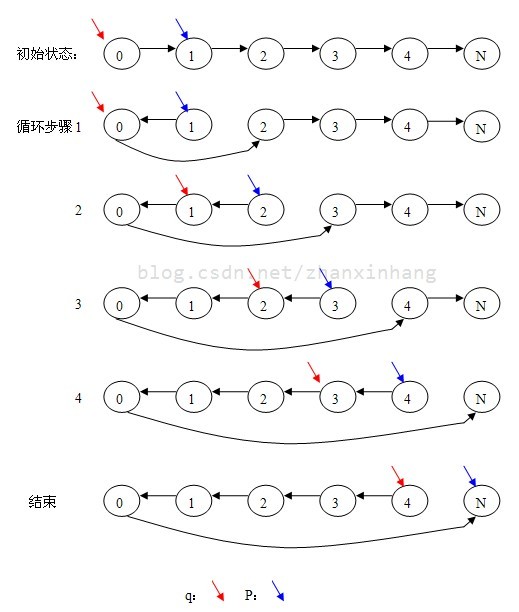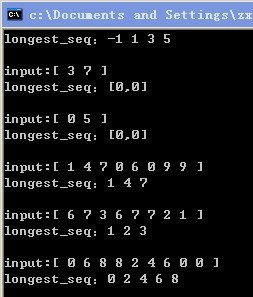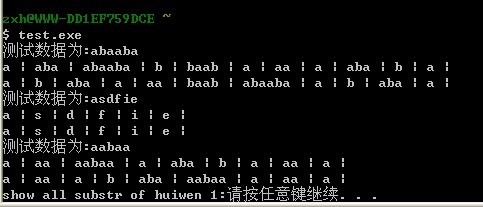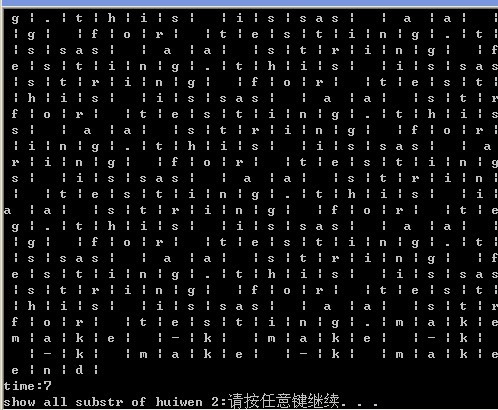每日微软面试题——day 1
<以下微软面试题全来自网络>
<以下答案与分析纯属个人观点,不足之处,还望不吝指出^_^>
题:.编写反转字符串的程序,要求优化速度、优化空间。
分析:构建两个迭代器p 和 q ,在一次遍历中,p的位置从字串开头向中间前进,q从字串末尾向中间后退,反转字串只要每次遍历都交换p和q所指向的内容即可,直到p和q在中间相遇,这时循环次数刚好等于 字串的长度/2。
实现代码:
- /**
- author: 花心龟
- blog:http://blog.csdn.net/zhanxinhang
- **/
- #include <stdio.h>
- void reverse(char *_str,int _l) //反转函数,_l指要反转字串的长度
- {
- char *p=_str,*q=_str+_l-1,temp;
- while(q>p)
- {
- temp=*p;
- *p=*q;
- *q=temp;
- p++;
- q--;
- }
- }
- int main()
- {
- charstr0[11]= "0123456789";
- reverse(str0,sizeof(str0)-1);
- printf("str0 = %s\n",str0);
- char str1[6]="01234";
- reverse(str1,sizeof(str1)-1);
- printf("str1 = %s",str1);
- return 0;
- }
题:.在链表里如何发现循环链接?
分析:可以构建两个迭代器p和pp,p一次向移动一个节点,pp一次移动两个节点,如果p和pp在某个时刻指向了同一个节点,那么该链表就有循环链接。
实现代码:
- /**
- Author:花心龟
- Blog:http://blog.csdn.net/zhanxinhang
- **/
- #include <stdio.h>
- #include <malloc.h>
- #define TEST
- struct list_node
- {
- int data;
- list_node * next;
- };
- list_node *head; //指向头结点
- void list_create()
- {
- int i;
- list_node *p=NULL;
- head = (list_node*)malloc(sizeof(list_node));
- head->data=0; //头结点数据设为
- head->next = NULL;
- p=head;
- for(i=1; i<6; i++) //创建个结点
- {
- p->next = (list_node*)malloc(sizeof(list_node));
- p->next->data = i;
- p->next->next = NULL;
- p=p->next;
- }
- p->next = head; //使尾结点的下一个结点指针指向头结点,构成循环链表
- #ifdef TEST
- p=head;
- for(i=0; i<12&&p!=NULL; i++)
- {
- printf("%d ",p->data);
- p=p->next;
- }
- printf("\n");
- #endif
- }
- void cycleList_test()
- {
- if(head==NULL || head->next == NULL)
- return;
- list_node *p=NULL,*pp=NULL;
- p=head;
- pp=head->next->next;
- while(p!=pp )
- {
- p=p->next;
- pp=pp->next->next;
- if(p==NULL || pp==NULL)
- {
- printf("不是循环链表");
- return ;
- }
- }
- printf("是循环链表");
- }
- void list_destroy()
- {
- list_node *pmove=NULL,*pdel=NULL;
- pmove=head->next;
- while(pmove!=head)
- {
- pdel=pmove;
- pmove=pmove->next;
- free(pdel);
- }
- free(head);
- }
- int main()
- {
- list_create(); //构建循环链表
- cycleList_test();//测试是否是循环链表
- list_destroy(); //销毁链表
- return 0;
- }
题:.给出洗牌的一个算法,并将洗好的牌存储在一个整形数组里。
分析:首先54张牌分别用0到53 的数值表示并存储在一个整形数组里,数组下标代表纸牌所在的位置。接下来,遍历整个数组,在遍历过程中随机产生一个随机数,并以该随机数为下标的数组元素与当前遍历到的数组元素进行对换。时间复杂度为O(n) (注:所得到的每一种结果的概率的分母越大越好)
实现代码:
- /**
- Author:花心龟
- Blog:http://blog.csdn.net/zhanxinhang
- **/
- #include <stdio.h>
- #include <time.h>
- #include <stdlib.h>
- void shuffle(int boke[]) //洗牌
- {
- int i,r,t;
- srand((unsigned)time(NULL)); //随机数种子
- for(i=0; i<54; i++)
- {
- r=(rand()%107)/2;
- //交换
- t=boke[i];
- boke[i]=boke[r];
- boke[r]=t;
- }
- }
- int main()
- {
- int boke[54],i;
- for(i=0;i<54;i++) //初始化纸牌
- boke[i]=i;
- printf("before shuffle:\n");
- for(i=0; i<54; i++) //打印
- printf("%d ",boke[i]);
- shuffle(boke); //洗牌
- printf("\nafter shuffle:\n");
- for(i=0; i<54; i++) //打印
- printf("%d ",boke[i]);
- return 0;
- }
题:写一个函数,检查字符串是否是整数,如果是,返回其整数值。
(或者:怎样只用4行代码编写出一个从字符串到长整形的函数?)
分析:略
实现代码:
- /**
- Author:花心龟
- Blog:http://blog.csdn.net/zhanxinhang
- **/
- #include <stdio.h>
- long convert(const char *str) // 4行代码?下面我用了四句语句,不知当不当否,权当娱乐^^
- {
- long value=0,f=1; //f将决定value是否为负数
- if(*str == '-') str++,f=-1;
- for(;*str!='\0' && *str>='0' && *str<='9'; str++)
- value=value*10+(*str-'0');
- return *str=='\0'?value*f:0; //如果不为整数返回
- }
- int main()
- {
- char str0[] = "1234567";
- printf("%d\n",convert(str0));
- char str1[] = "4.56";
- printf("%d\n",convert(str1));
- char str2[] = "-1234567";
- printf("%d\n",convert(str2));
- char str3[] = "-4.56";
- printf("%d\n",convert(str3));
- return 0;
- }
题:怎样从顶部开始逐层打印二叉树结点数据?请编程。
分析:不用递归,定义两个栈(或数组),也能方便漂亮地搞定。首先栈1存储第一层中的节点也就是根节点,然后每次循环,打印栈1中的元素,再将栈1中的节点更新为下一层中的节点。总共循环logn+1次。
实现代码(以下遗漏了对二叉树的销毁操作):
- /**
- Author:花心龟
- Blog:http://blog.csdn.net/zhanxinhang
- **/
- #include <stdio.h>
- #include <malloc.h>
- typedef struct bt_node
- {
- int data;
- struct bt_node *rchild;
- struct bt_node *lchild;
- }BinTree,node_t;
- BinTree *myTree;
- node_t* bt_new_node(int data)
- {
- node_t* node = (node_t*)malloc(sizeof(node_t));
- node->rchild = NULL;
- node->lchild = NULL;
- node->data = data;
- return node;
- }
- void bt_create()
- {
- //第一层根节点,数字11表示第一层的第一个位置,以下类似
- myTree = bt_new_node(11);
- //创建第二层节点
- myTree->lchild = bt_new_node(21);
- myTree->rchild = bt_new_node(22);
- //创建第三层节点
- myTree->lchild->lchild = bt_new_node(31);
- myTree->lchild->rchild = bt_new_node(32);
- myTree->rchild->lchild = bt_new_node(33);
- myTree->rchild->rchild = bt_new_node(34);
- //创建第四层节点
- myTree->rchild->rchild->rchild = bt_new_node(48);
- }
- void print_layer_by_layer() //逐层打印二叉树非递归算法(主题)
- {
- node_t* stack1[100]={0};//栈
- node_t* stack2[100]={0};//栈
- int T1=0,T2=0; //栈顶下标
- stack1[T1++]=myTree; //根节点入栈
- while(T1) //若栈为空则停止循环
- {
- while(T1)
- {
- T1--;
- printf("%d ",stack1[T1]->data); //打印栈顶元素
- stack2[T2++]=stack1[T1]; //将栈元素转存到栈2中
- }
- printf("\n");
- //此时栈已存储了当前行的各元素
- //通过栈得到下一行中的节点并更新到栈中
- while(T2)
- {
- T2--;
- if(stack2[T2]->rchild != NULL)
- stack1[T1++]=stack2[T2]->rchild;
- if(stack2[T2]->lchild != NULL)
- stack1[T1++]=stack2[T2]->lchild;
- }
- }
- }
- int main()
- {
- bt_create(); //创建二叉树
- print_layer_by_layer(); //逐层打印
- return 0;
- }
另:关于此题的其它想法请看3楼我的回复,回复上的编码步骤为广度优先遍历二叉树算法,不过本人不才哈,不知题目中的意思是一层一层的打印呢,还是按照层的顺序从左到右一个一个打印呢(好像也是逐层打印),且不管它,通过对两种算法比较,上面使用栈的算法功能更强,至少打完一层可以再打一个回行。而使用队列的广度优先遍历二叉树算法有效率优势,且代码简洁易懂,就是不能打完一层后回行。^_^ 纯属个人观点,望不吝指教。
题:怎样把一个链表掉个顺序(也就是反序,注意链表的边界条件并考虑空链表)?
分析:这题比较有意思,我想了个高效的实现。首先定义两个迭代器 p 和 q,q从第一个节点开始遍历,p从第二个节点开始遍历,每次遍历将头指针的next指向p的next,然后将p的next 反指向q(此时q是p的前一个节点),也就是说将每个节点的链接方向掉过来,最后尾节点变成了头节点,头节点变成了尾节点,时间复杂度为高效的O(n)
图示:(最后一个N指空节点)

以下便是是我简洁的实现代码:
- /**
- Author:花心龟
- Blog:http://blog.csdn.net/zhanxinhang
- **/
- #include <stdio.h>
- #include <malloc.h>
- #define TEST
- typedef struct list_node
- {
- int data;
- structlist_node * next;
- }list_node;
- list_node *head; //头结点
- void list_create()
- {
- int i;
- list_node *p;
- head = (list_node*)malloc(sizeof(list_node));
- head->data=0; //头结点数据设为
- head->next = NULL;
- p=head;
- for(i=1;i<6; i++) //创建5个结点
- {
- p->next = (list_node*)malloc(sizeof(list_node));
- p->next->data = i;
- p->next->next = NULL;
- p=p->next;
- }
- #ifdef TEST
- p=head;
- while(p!=NULL) //打印该链表
- {
- printf("%d",p->data);
- p=p->next;
- }
- printf("\n");
- #endif
- }
- void list_reverse() //使链表反序 (主题)
- {
- printf("^^after reversing:\n");
- if(head == NULL || head->next==NULL) return ;//如果head为空,则返回
- list_node *p,*q;
- q=head;
- p=head->next;
- while(p!=NULL)
- {
- head->next=p->next; //将头指针的next指向p的下一个节点
- p->next=q; //将p的next值反指向它的前一个节点q
- q=p; //q移向p的位置
- p=head->next; //p移向它的下一个位置
- }
- head = q;
- #ifdef TEST
- p=head;
- while(p!=NULL) //打印该链表
- {
- printf("%d",p->data);
- p=p->next;
- }
- printf("\n");
- #endif
- }
- void list_destroy() //销毁函数
- {
- list_node *pmove=NULL,*pdel=NULL;
- pmove=head;
- while(pmove!=head)
- {
- pdel=pmove;
- free(pdel);
- pmove=pmove->next;
- }
- }
- int main()
- {
- list_create(); //构建单链表
- list_reverse(); //反转链表
- list_destroy(); //销毁链表
- return 0;
- }
题:求随机数构成的数组中找到长度大于=3的最长的等差数列
输出等差数列由小到大:
如果没有符合条件的就输出[0,0]
格式:
输入[1,3,0,5,-1,6]
输出[-1,1,3,5]
要求时间复杂度,空间复杂度尽量小
分析:基本算法思路(采用动态规划思想):首先,只要得到数列的公差和一个首项就可以确定一个等差数列,因此我们要寻找最长等差数列的公差以及首项。其次,为了方便查找公差和首项,我们应该将原数组进行由小到大排序,这样各两数之间的公差也是成递增形势的,这样我们就可以避免回溯查找首项。
因此,在搜寻公差及首项的过程中,我们可以分两三个决策阶段:
1、如果公差为0,应该做何处理。
2、如果公差不为0,应该做何处理。
3、如果找到的数列长度是当前最长的做相应的处理
针对以上情况,我们应该选择一种合适的数据结构——平衡排序树,stl中的set,map,mutiset,multimap是以红黑树结构为形势的容器,无疑是非常合适的,根据题目情况,可能存在具有相同元素的数组,因此我们选择multiset,这样无论我们对数据进行插入排序,查找都是比较高效的,因此总体上是可以满意的。
最后有几项时间上的优化不在这里说明,详情可看代码。若有不足之处,望能不吝指出!^_^
我的实现代码:
- /**
- Author:花心龟
- Blog:http://blog.csdn.net/zhanxinhang
- **/
- #include <iostream>
- #include <ctime>
- #include <set>
- using namespace std;
- void show_longest_seq(const multiset<int>& myset)
- {
- int maxLength = 0, curr_pos = 0, curr_d = 0, counter=0,i=0; //一些辅助变量
- int d_result, a1_result; //存储最长等差数列的公差以及首项
- multiset<int>::const_iterator set_it1,set_it2;
- /*
- (主题)寻找长度最长的等差数列,最坏情况下时间复杂度为O(n^3)
- */
- for(set_it1 = myset.begin(); set_it1 != myset.end();)
- {
- for(set_it2=set_it1,set_it2++; set_it2 != myset.end();)//第二层循环从set_it1所指的下一个元素开始遍历
- {
- curr_d = *set_it2 - *set_it1; //算得当前公差,注意由于set为自排序容器,从小到大排列,所以curr_d恒为正
- if(curr_d == 0) // 如果公差为0
- {
- counter = myset.count(*set_it1);
- set_it2 = myset.upper_bound(*set_it1);//(优化项)跳过与set_it1相等的元素
- }
- else
- {
- counter = 2; //(优化项)最小长度要求要不小于所以直接从开始累加
- while(myset.find(*set_it1 + counter*curr_d) != myset.end()) //计算数列项个数
- ++counter;
- set_it2 = myset.upper_bound(*set_it2);// (优化项)跳过与*set_it2相等的元素
- }
- if(counter > maxLength) //如果新数列长度大于maxLength
- {
- d_result = curr_d;
- a1_result = *set_it1;
- maxLength = counter;
- }
- }
- curr_pos += myset.count(*set_it1); //计算第一层循环遍历到的当前位置
- if(myset.size()-curr_pos < maxLength) // (优化项)如果集合中剩下的元素小于最大数列长度,就退出循环
- break;
- set_it1 = myset.upper_bound(*set_it1); //下一次set_it1 的位置,并跳过相同元素
- }
- /*
- 打印最长等差数列
- */
- if(maxLength <= 2)
- {
- cout<<"longest_seq:[0,0]"<<endl;
- }
- else
- {
- cout<<"longest_seq:";
- for(i = 0; i<maxLength; i++)
- cout<<*(myset.find(a1_result + i*d_result))<<' ';
- cout<<endl;
- }
- }
- //Blog:http://blog.csdn.net/zhanxinhang
- test in main
- int main()
- {
- int a[]={1,3,0,5,-1,6};
- multiset<int> myset;
- myset.insert(a,a+6);
- show_longest_seq(myset);
- cout<<endl;
- int l;
- srand((unsigned)time(NULL));
- for(int j = 0; j < 5; j++)
- {
- myset.clear();
- cout<<"input:[ ";
- l=rand()%10;
- for(int i = 0; i < l; ++i)
- {
- int element = rand()%10;
- myset.insert(element);
- cout<<element<<' ';
- }
- cout<<']'<<endl;
- show_longest_seq(myset);
- cout<<endl;
- }
- return 0;
- }
附一张测试结果图:

题:两个链表,一升一降。合并为一个升序链表。
分析:(假设升序的链表为链表1,降序的链表为链表2,p1,p2分别作为它们的迭代器,还有一个合并链表用于存放合并后的数据)
法一、最容易想到的且容易实现的就是使两个表都变成升序,然后就是经典的合并排序算法的步骤了,步骤是构建p1,p2两个迭代器,分别用于迭代两个链表,每次遍历,若p1所指的节点数据大于p2所指的节点数据则将p1所指的节点数据插入到要合并链表中去且使p1指向下一个节点,否则将p2将所指的节点数据插入到合并链表中去且使p2指向下一个节点,直到p1和p2任意一个指向了NULL为止。最后可能两个链表中尚有剩余的节点,将其逐个插入到合并链表中去即可。
法二、使用递归方法后序遍历降序链表2,遍历顺序就相当于升序的顺序了。在递归遍历链表2的过程中,需要处理有以下三件事:(注意顺序)
(1) 如果p2的数据小于p1的就插入到合并链表中 (2) 如果p2的数据大于p1,那么就对链表1循环遍历,每次将p1中的数据插到合并链表中,直到p2不大于p1,且p1不为空 (3) 如果p1为空,就直接将p2插入到合并链表中
(这个方法你想到了没!)
- /**
- Author:花心龟
- Blog:http://blog.csdn.net/zhanxinhang
- **/
- #include <stdio.h>
- #include <malloc.h>
- #include <stdlib.h>
- typedef struct list_node
- {
- int data;
- struct list_node * next;
- }list_node;
- list_node *list1=NULL; //链表头结点
- list_node *list2=NULL; //链表头结点
- void list_print(const list_node *p)//打印该链表函数
- {
- if(p==NULL)return;
- while(p!=NULL)
- {
- printf("%d ",p->data);
- p=p->next;
- }
- printf("\n");
- }
- void list_create(list_node* &head, int data[], int N)
- {
- if(data == NULL) return;
- int i;
- list_node *p;
- p = (list_node*)malloc(sizeof(list_node));
- p->data = data[0];
- p->next = NULL;
- head = p;
- for(i=1;i<N; i++)
- {
- p->next = (list_node*)malloc(sizeof(list_node));
- p->next->data = data[i];
- p->next->next = NULL;
- p=p->next;
- }
- }
- void list_reverse(list_node* &head) //使链表反序
- {
- if(head == NULL) return ;//如果head1为空,则返回
- list_node *p,*q;
- q=head;
- p=head->next;
- while(p!=NULL)
- {
- head->next=p->next; //将头指针的next指向p的下一个节点
- p->next=q; //将p的next值反指向它的前一个节点q
- q=p; //q移向p的位置
- p=head->next; //p移向它的下一个位置
- }
- head = q;
- }
- void list_destroy(list_node *head) //销毁函数
- {
- list_node *pmove=NULL,*pdel=NULL;
- pmove=head;
- while(pmove!=head)
- {
- pdel=pmove;
- free(pdel);
- pmove=pmove->next;
- }
- }
- list_node* merge_two_list() //合并链表1和链表2(法一)
- {
- list_reverse(list2); //反转链表使之与链表一样升序排列
- list_node *list_merged; //和并后的链表
- list_node *p1,*p2,*p0;
- list_merged = (list_node*)malloc(sizeof(list_node));
- list_merged->data = 0;
- list_merged->next = NULL;
- p0 = list_merged;
- p1=list1;
- p2=list2;
- while(p1!=NULL && p2!=NULL)
- {
- if(p1->data < p2->data)
- {
- p0->next=(list_node*)malloc(sizeof(list_node));
- p0->next->data=p1->data;
- p0->next->next=NULL;
- p0=p0->next;
- p1=p1->next;
- }
- else
- {
- p0->next=(list_node*)malloc(sizeof(list_node));
- p0->next->data=p2->data;
- p0->next->next=NULL;
- p0=p0->next;
- p2=p2->next;
- }
- }
- while(p1!=NULL)
- {
- p0->next=(list_node*)malloc(sizeof(list_node));
- p0->next->data=p1->data;
- p0->next->next=NULL;
- p0=p0->next;
- p1=p1->next;
- }
- while(p2!=NULL)
- {
- p0->next=(list_node*)malloc(sizeof(list_node));
- p0->next->data=p2->data;
- p0->next->next=NULL;
- p0=p0->next;
- p2=p2->next;
- }
- return list_merged;
- }
- list_node* p0=(list_node*)malloc(sizeof(list_node));
- list_node* phead=p0;
- list_node* &p1=list1; //p1与list1绑定
- list_node* foreach(list_node* p2) //递归合并(法二)
- {
- if(p2==NULL) return phead;
- foreach(p2->next);
- if(p1->data > p2->data)
- {
- p0->next = (list_node*)malloc(sizeof(list_node));
- p0->next->data = p2->data;
- p0->next->next = NULL;
- p0=p0->next;
- return phead;
- }
- while(p1!=NULL && p1->data<=p2->data)
- {
- p0->next = (list_node*)malloc(sizeof(list_node));
- p0->next->data = p1->data;
- p0->next->next = NULL;
- p0=p0->next;
- p1 = p1->next;
- }
- if(p1==NULL)
- {
- p0->next = (list_node*)malloc(sizeof(list_node));
- p0->next->data = p2->data;
- p0->next->next = NULL;
- p0=p0->next;
- }
- return phead;
- }
- //Blog:http://blog.csdn.net/zhanxinhang
- int main()
- {
- int list1_data[] = {1,4,6,8,10}; //链表数据升序 可在这里该数据进行测试
- int list2_data[] = {14,9,3,2}; //链表数据降序
- list_create(list1,list1_data,5); //构建单链表
- list_create(list2,list2_data,4); //构建单链表
- list_print(list1);
- list_print(list2);
- //list_node *list_merged=merge_two_list(); //合并两个链表
- //list_print(list_merged->next); //打印合并后的链表
- list_node *list_merged2=foreach(list2); //使用递归合并两个链表
- list_print(list_merged2->next);
- list_destroy(list1); //销毁链表
- list_destroy(list2); //销毁链表
- // list_destroy(list_merged); //销毁合并后的链表
- list_destroy(list_merged2); //销毁合并后的链表
- system("pause");
- return 0;
- }
题:如何删除链表的倒数第m的元素?
分析:构建p0,p1两个迭代器,初始使p0和p1指向头结点,接着使p1移动到第m+1项,然后指向头得p0与p1同时前进,当p1指向空节点的时候结束,这时p0所指的位置就是倒数第m个,时间复杂度为O(n)
实现代码:(为了学习的需要,现在C++朋友采用c++实现,不能满足c朋友要采用c实现的愿望,此实为c++朋友的遗憾,不过一切重在思想。^_^)
- /**
- Author:花心龟
- Blog:http://blog.csdn.net/zhanxinhang
- **/
- #include <iostream>
- #include <list>
- using namespace std;
- class App
- {
- list<int> *plist;
- void delete_node_at_last(int m) //today`s topic
- {
- list<int>::iterator p0, p1;
- p0=p1=p2=plist->begin();
- //使p1移到第m+1项
- for(int i=1; i<=m; i++)
- p1++;
- //p0和p1同时前进,当p1到达终点时p0所指向的就是倒数第m个节点
- while(p1!=plist->end())
- p0++,p1++;
- //删除节点
- plist->erase(p0);
- }
- void create_list()
- {
- int list_data[]={1,2,3,4,5,6,7,8,9}; //链表数据
- plist = new list<int>(list_data, list_data+sizeof(list_data)/sizeof(int));
- }
- void print_list()
- {
- list<int>::iterator it;
- for(it=plist->begin(); it!=plist->end(); it++)
- cout<<*it<<' ';
- }
- public:
- //test in run funtion
- void run()
- {
- create_list();
- delete_node_at_last(3); //删除倒数第三个节点
- print_list();
- }
- ~App()
- {
- delete plist;
- }
- };
- //Blog:http://blog.csdn.net/zhanxinhang
- int main()
- {
- App myapp;
- myapp.run();
- system("pause");
- return 0;
- }
题:1、如何判断一个字符串是对称的?如a,aa,aba。
2、如何利用2函数找出一个字符串中的所有对称子串?
分析:
且看第一个问题判断字符串对称,有以下两种方法。
方法一、使迭代器p1指向头,p2指向尾。使p1,p2相对而行(—> | <—),每次比较p1,p2是否相等,直到它们相遇。
方法二、使p1、p2指向中间的一个元素(如果字符串长度为偶数的话就指向中间两个相邻的元素),使它们相向而行(<— |—>),每次比较p1,p2是否相等。直到它们一个指向头一个指向尾便结束。
(可以看出方法1明显好于方法2)
现在看第二个问题打印所有的对称子串,判断对称子串的问题我们似乎已经解决,且有以上两种方法,针对现在的情况是否两种都合适呢,确切的说不是。如果是方法一,请想象一下,如果要p1,p2一个指向子串的头一个指向子串的尾,那么至少要两层循环一层控制p1一层控制p2,还有一层循环用于判断子串是否对称,也就是说总共需要三层嵌套循环,时间复杂度指数为3。而如果选择方法二呢? 两层循环就能实现,不过要适应现在这种情况需要做些修改,就是针对偶数长度的子串进行一次遍历,再针对奇数长度的子串进行一次遍历,也就是两层嵌套循环中内层有两次循环,时间复杂度指数为2。详情且看代码。
实现加测试代码:
- /**
- Author:花心龟
- Blog:http://blog.csdn.net/zhanxinhang
- **/
- #include <iostream>
- #include <cstdlib>
- #include <ctime>
- using namespace std;
- class App
- {
- typedef string::iterator Iter_t;
- string m_str;
- void print(Iter_t p1, Iter_t p2) //打印从p1开始到p2结束的字符
- {
- while(p1<=p2)
- {
- cout<<*p1;
- p1++;
- }
- cout<<" | ";
- }
- bool isHuiwen1(Iter_t start,Iter_t end) //法1判断是否为对称子串
- {
- Iter_t p1 = start;
- Iter_t p2 = end;
- int times = (distance(p1,p2)+1) / 2; //比较次数
- while(times)
- {
- if(*p1 != *p2)
- return false;
- p1++;
- p2--;
- times--;
- }
- return true;
- }
- bool isHuiwen2(Iter_t mid_it) //法2判断是否为对称子串
- {
- Iter_t p1,p2;
- p1 = p2 = mid_it;
- while(p1>=m_str.begin() && p2 < m_str.end())
- {
- if(*p1 != *p2)
- break;
- print(p1,p2);//打印从p1到p2的字符
- p1--,p2++;
- }
- p1 = p2 = mid_it;
- p2++; //使p2向前移动一个位置,此时p1,p2分别指向中间两个相邻位置
- while(p1>=m_str.begin() && p2 < m_str.end())
- {
- if(*p1 != *p2)
- return false;
- print(p1,p2);//打印从p1到p2的字符
- p1--,p2++;
- }
- return true;
- }
- void show_all_substr_of_huiwen1() //法一打印所有对称子串
- {
- Iter_t p2=m_str.end()-1;
- Iter_t p1 = m_str.begin();
- for(;p1!=m_str.end();p1++)
- for(p2=p1;p2!=m_str.end();p2++)
- {
- if(isHuiwen1(p1,p2))
- print(p1,p2);
- }
- }
- void show_all_substr_of_huiwen2() //法二打印所有对称子串
- {
- Iter_t it = m_str.begin();
- for(;it!=m_str.end();it++)
- {
- isHuiwen2(it);
- }
- }
- public:
- void run()
- {
- m_str="abaaba";
- cout<<"测试数据为:abaaba"<<endl;
- show_all_substr_of_huiwen1();
- cout<<endl;
- show_all_substr_of_huiwen2();
- cout<<endl;
- m_str="asdfie";
- cout<<"测试数据为:asdfie"<<endl;
- show_all_substr_of_huiwen1();
- cout<<endl;
- show_all_substr_of_huiwen2();
- cout<<endl;
- m_str="aabaa";
- cout<<"测试数据为:aabaa"<<endl;
- show_all_substr_of_huiwen1();
- cout<<endl;
- show_all_substr_of_huiwen2();
- cout<<endl;
- //时间比较//
- m_str="this is a string for testing. aabaa alskjdfkljasdjflasdflkajsldkjfsjlakjsdlfjwoekjlakjlsdkjflsajlkdjfowieuoriuq aaddbb sldjfalkjsdlfkjasldjflajsldfjalskdjflakjsdlfkjaslkdjflajsdlfkjaslkdjflkajsdlkjflkasjdlfjaklsjdkfljaklsdjfklsajdflkjslkdjflaskjdlfkjalsdjlfkajsldfkjlaksjdfljasldjflaskjdfkasjdflaksjdkfljaskldfjlaksjdfljasldjflaksjdkljfkalsjdlkfjasldjflasjdlfjasldjfklsajdfljaskldfjlsakjdflkasjdfkl this is a string for testing.this is a string for testing.this is a string for testing.this is a string for testing.this is a string for testing.this is a string for testing.this is a string for testing.this is a string for testing.this is a string for testing.this is a string for testing.this is a string for testing.this is a string for testing.this is a string for testing.this is a string for testing.this is a string for testing.this is a string for testing.this is a string for testing.this is a string for testing.this is a string for testing.this is a string for testing.this is a string for testing.this is a string for testing.this is a string for testing.this is a string for testing.this is a string for testing.this is a string for testing.this is a string for testing.this is a string for testing.this is a string for testing.this is a string for testing.this is a string for testing.this is a string for testing.this is a string for testing.this is a string for testing.this is a string for testing.this is a string for testing.this is a string for testing.this is a string for testing.this is a string for testing.this is a string for testing.this is a string for testing.this is a string for testing.this is a string for testing.this is a string for testing.this is a string for testing.this is a string for testing.this is a string for testing.this is a string for testing.this is a string for testing.this is a string for testing.this is a string for testing.this is a string for testing.this is a string for testing.this is a string for testing.this is a string for testing.this is a string for testing.this is a string for testing.this is a string for testing.this is a string for testing.this is a string for testing.this is a string for testing.this is a string for testing.this is a string for testing.this is a string for testing.this is a string for testing.this is a string for testing.this is a string for testing.this is a string for testing.this is a string for testing.this is a string for testing.this is a string for testing.this is a string for testing.make -k make -k make -k make -k make -k make -k is is a string for testing.this is a string for testing.this is a string for testing.this is a string for testing.this is a string for testing.this is a string for testing.this is a string for testing.this is a string for testing.this is a string for testing.this is a string for testing.this is a string for testing.this is a string for testing.this is a string for testing.this is a string for testing.this is a string for testing.this is a string for testing.this is a string for testing.this is a string for testing.this is a string for testing.this is a string for testing.make -k make -k make -k make -k make -k make -k is is a string for testing.this is a string for testing.this is a string for testing.this is a string for testing.this is a string for testing.this is a string for testing.this is a string for testing.this is a string for testing.this is a string for testing.this is a string for testing.this is a string for testing.this is a string for testing.this is a string for testing.this is a string for testing.this is a string for testing.this is a string for testing.this is a string for testing.this is a string for testing.this is a string for testing.this is a string for testing.make -k make -k make -k make -k make -k make -k is is a string for testing.this is a string for testing.this is a string for testing.this is a string for testing.this is a string for testing.this is a string for testing.this is a string for testing.this is a string for testing.this is a string for testing.this is a string for testing.this is a string for testing.this is a string for testing.this is a string for testing.this is a string for testing.this is a string for testing.this is a string for testing.this is a string for testing.this is a string for testing.this is a string for testing.this is a string for testing.make -k make -k make -k make -k make -k make -k is is a string for testing.this is a string for testing.this is a string for testing.this is a string for testing.this is a string for testing.this is a string for testing.this is a string for testing.this is a string for testing.this is a string for testing.this is a string for testing.this is a string for testing.this is a string for testing.this is a string for testing.this is a string for testing.this is a string for testing.this is a string for testing.this is a string for testing.this is a string for testing.this is a string for testing.this is a string for testing.make -k make -k make -k make -k make -k make -k is is a string for testing.this is a string for testing.this is a string for testing.this is a string for testing.this is a string for testing.this is a string for testing.this is a string for testing.this is a string for testing.this is a string for testing.this is a string for testing.this is a string for testing.this is a string for testing.this is a string for testing.this is a string for testing.this is a string for testing.this is a string for testing.this is a string for testing.this is a string for testing.this is a string for testing.this is a string for testing.make -k make -k make -k make -k make -k make -k is is a string for testing.this is a string for testing.this is a string for testing.this is a string for testing.this is a string for testing.this is a string for testing.this is a string for testing.this is a string for testing.this is a string for testing.this is a string for testing.this is a string for testing.this is a string for testing.this is a string for testing.this is a string for testing.this is a string for testing.this is a string for testing.this is a string for testing.this is a string for testing.this is a string for testing.this is a string for testing.make -k make -k make -k make -k make -k make -k is is a string for testing.this is a string for testing.this is a string for testing.this is a string for testing.this is a string for testing.this is a string for testing.this is a string for testing.this is a string for testing.this is a string for testing.this is a string for testing.this is a string for testing.this is a string for testing.this is a string for testing.this is a string for testing.this is a string for testing.this is a string for testing.this is a string for testing.this is a string for testing.this is a string for testing.this is a string for testing.make -k make -k make -k make -k make -k make -k is is a string for testing.this is a string for testing.this is a string for testing.this is a string for testing.this is a string for testing.this is a string for testing.this is a string for testing.this is a string for testing.this is a string for testing.this is a string for testing.this is a string for testing.this is a string for testing.this is a string for testing.this is a string for testing.this is a string for testing.this is a string for testing.this is a string for testing.this is a string for testing.this is a string for testing.this is a string for testing.make -k make -k make -k make -k make -k make -k is is a string for testing.this is a string for testing.this is a string for testing.this is a string for testing.this is a string for testing.this is a string for testing.this is a string for testing.this is a string for testing.this is a string for testing.this is a string for testing.this is a string for testing.this is a string for testing.this is a string for testing.this is a string for testing.this is a string for testing.this is a string for testing.this is a string for testing.this is a string for testing.this is a string for testing.this is a string for testing.make -k make -k make -k make -k make -k make -k is is a string for testing.this is a string for testing.this is a string for testing.this is a string for testing.this is a string for testing.this is a string for testing.this is a string for testing.this is a string for testing.this is a string for testing.this is a string for testing.this is a string for testing.this is a string for testing.this is a string for testing.this is a string for testing.this is a string for testing.this is a string for testing.this is a string for testing.this is a string for testing.this is a string for testing.this is a string for testing.make -k make -k make -k make -k make -k make -k is is a string for testing.this is a string for testing.this is a string for testing.this is a string for testing.this is a string for testing.this is a string for testing.this is a string for testing.this is a string for testing.this is a string for testing.this is a string for testing.this is a string for testing.this is a string for testing.this is a string for testing.this is a string for testing.this is a string for testing.this is a string for testing.this is a string for testing.this is a string for testing.this is a string for testing.this is a string for testing.make -k make -k make -k make -k make -k make -k end";
- time_t start,record1;
- cout<<"show all substr of huiwen 1:";
- system("pause");
- start = time(NULL);
- show_all_substr_of_huiwen1();
- record1 = time(NULL);
- cout<<endl;
- cout<<"time:"<<record1-start;
- cout<<endl;
- cout<<"show all substr of huiwen 2:";
- system("pause");
- start = time(NULL);
- show_all_substr_of_huiwen2();
- record1 = time(NULL);
- cout<<endl;
- cout<<"time:"<<record1-start;
- cout<<endl;
- cout<<"(可以看到打印速度明显快于上一次)";
- }
- };
- int main()
- {
- App myapp;
- myapp.run();
- system("pause");
- return 0;
- }
测试结果:

各测试数据下的一二行为打印出来的所有对称字串。
按下任意键后:

以上是使用方法1打印出来的结果。
按下任意键后:

以上便是用方法2打印出来的结果。
题:假设你有一个用1001个整数组成的数组,这些整数是任意排列的,但是你知道所有的整数都在1到1000(包括1000)之间。此外,除一个数字出现两次外,其他所有数字只出现一次。假设你只能对这个数组做一次处理,用一种算法找出重复的那个数字。如果你在运算中使用了辅助的存储方式,那么你能找到不用这种方式的算法吗?
分析:
方法一、若使用辅助的存储方式,该选择何种存储方式呢?可使用hash的存储方式,以1到1000作为hash表的索引,遍历原数组,统计各数字出现的个数并存储到以该数字为索引值的hash表中,若某个hash[x]的值为2则退出循环,x就是重复出现两次的数字。时间复杂度最坏是O(n)。优点:高效率,缺点:消耗的内存空间过大。代码如下:
- int fun1(const int a[])
- {
- int hash[1002]={0};
- int x=0;
- for(int i = 0; i<1001; i++)
- {
- if((++hash[a[i]]) == 2)
- {
- x = a[i];
- break;
- }
- }
- return x;
- }
方法二、若不使用辅助的存储方式呢?已知1001个整数组成的数组只有一个数字出现了两次,且整数都在1到1000之间,所以可推得数组里面包含了1到1000之间的所有数字为[1,2,3……1000]和一个出现两次的x为1到1000中的任一个数字。这样就可以计算原数组里的所有数字之和S1和等差数列[1,2,3……1000]的和S2,再计算S1与S2之差,该差就是原数组中出现两次的数字x。时间复杂度是固定的O(n)。优缺点:内存空间消耗几乎没有,但是效率要输于使用hash表的存储方式。代码如下:
- int fun2(const int a[])
- {
- int s1=0,s2;
- s2 = 1001*1000/2;
- for(int i = 0; i<1001; i++)
- {
- s1+=a[i];
- }
- return s1-s2;
- }
















-TextView显示表情图像和文字)


